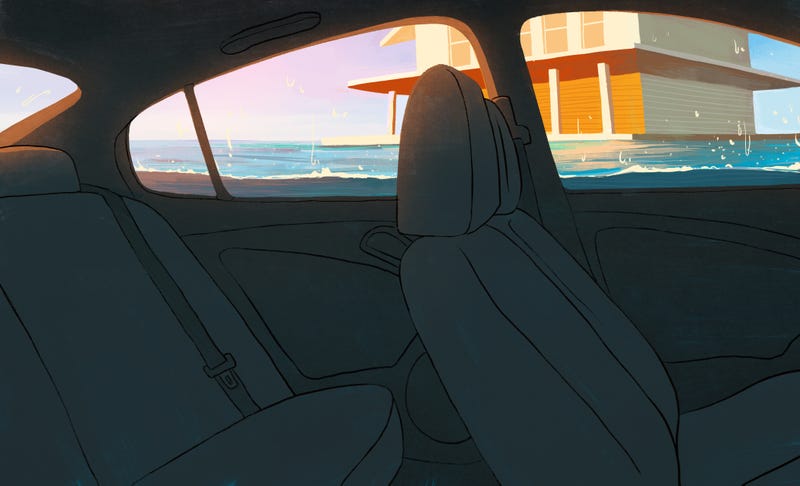How to Survive a Flash Flood

Awareness and prevention is always going to be your best chance of survival. Flash flooding can occur without obvious visual cues like clouds and heavy rain, so sign up for local weather alerts, and be sure to check local forecasts if weather starts to look a little questionable. A flood “watch” means flooding is possible in your area. A flood “warning” means flooding is already occurring and you should be ready to evacuate if things get bad. It also helps to know what spots are most likely to flood in your area. Take note of canyons, drainage channels, streambeds, and other low locations. Flood insurance is also a good idea if you live in areas prone to flash flooding. Just make sure you acquire it sooner rather than later as it takes 30 days for flood insurance to kick in.
How to Survive If You’re on Foot
As soon as you receive word of a flash flood, immediately head for higher ground and stay put until help arrives. If you see floodwaters, follow the NOAA’s advice and “turn around, don’t drown.” That means avoiding all moving water, even if it seems to be very shallow. Just six inches of moving water can trip you up and knock you over. You could hit your head, break a bone, or worse, get swept away into much deeper, faster-moving water. Anything deeper than your ankles is bad news, especially at night when it’s much harder to see.If you have no choice but to walk through water, go where the water is shallow and isn’t moving, then use a sturdy stick to check the depth as you walk, as well the firmness of the ground underneath. Mud and other slick surfaces can also easily topple you over. If you have children with you, carry them and keep them out of the water at all times if possible. As you make your way to higher ground, avoid touching or getting near any electrical equipment since you’re probably wet or standing in water. And if floodwaters have reached your home, do not use your home’s power.
If you get swept away by floodwaters, Desmond Johnson of Utah’s Unified Fire Authority’s Swift Water Rescue team suggests you grab or climb onto something as soon as you are able. As you move through the water, float backwards on your back so you can push away from any large debris flowing down the water toward you, and always go over obstacles, never under. Once you’ve got a good grip on something, keep your feet pointed downstream, then yell loudly for help and wave an arm if possible. Johnson says it’s hard for rescue teams to spot people trapped in the water, so anything you can do to make yourself more noticeable is a big help. Don’t give up—keep yelling and waving until you’re rescued.
How to Survive If You’re in a Car
Driving can also be incredibly dangerous during a flash flood. FEMA guidelines suggest that as little as six inches of water can cause loss of control and possibly stall your vehicle, a foot of water can actually float many vehicles, and two feet of rushing water is enough to carry SUVs and pickup trucks away. Not to mention, it can take as little as a quarter-inch of water to cause hydroplaning if you’re driving fast enough. Slow down and keep your eyes peeled.If it isn’t clear already, do not ever attempt a water crossing with your vehicle. It will not go well. Besides, you can’t accurately tell how deep water is from inside your vehicle, and you could be driving right into a sinkhole. Turn around and find another route. A good portion of the roughly 80 flood deaths that occur every year are due to poor decisions made with vehicles.
If the water comes at your vehicle suddenly and you have no time to get away, you need to get out as quickly as possible. If you’re stuck and the water is rising, unbuckle your seatbelt, roll down your windows, break them with a specialized tool, or kick them out to allow water to flow freely into the vehicle. If you don’t, you won’t be able to open your doors because nearly 2,000 pounds of pressure will be pushing against it. Once water comes in and the pressure equalizes on both sides—which will take less than a minute—you’ll be able to open the car doors or swim out of the window opening. Abandon your car and move to higher ground following the on-foot rules explained above.
How to Stay Safe After the Flood
Flood environments can still be dangerous even after the rain and rushing water is gone. Don’t go home until authorities say it’s safe, and listen to news reports to make sure the local water supply is still safe to drink. Also, stay out of any leftover pools of floodwater, and continue to avoid all moving water. It could be contaminated with all sorts of nasty stuff, like oil, gasoline, and sewage, and it may even be electrically charged from downed power lines.As you make your way home, stay aware and watch for areas that were clearly damaged by floodwaters. Weakened roads, bridges, and other routes can be dangerous to drive over. Take the safest route possible. If your home is surrounded and filled by floodwaters, do not go inside. It’s too dangerous. The water could be electrically charged and the building could be structurally unsafe. Even if your home was only slightly flooded during the storm, be extra cautious about using your home’s power. Lastly, be sure to clean and disinfect everything that got wet or muddy during the flood to avoid any further contamination or health hazards.

The Complete Guide to What To Do Before, During, and After a Disaster
Do you know how to actually protect yourself during an earthquake or hurricane? What about a…Read m

No comments:
Post a Comment